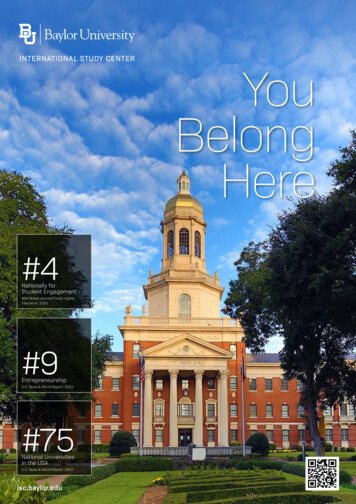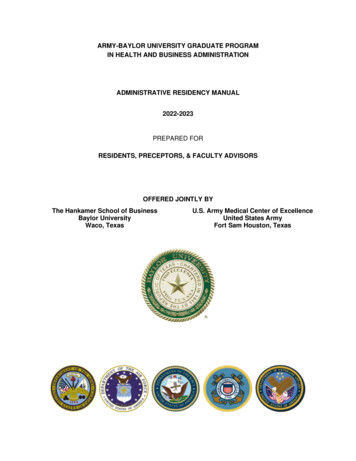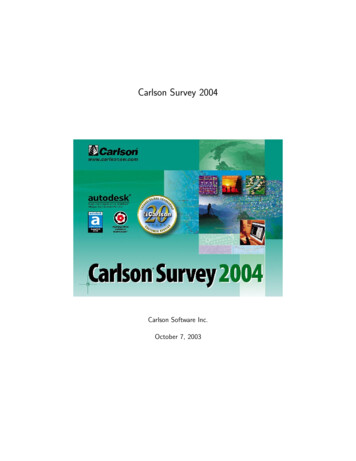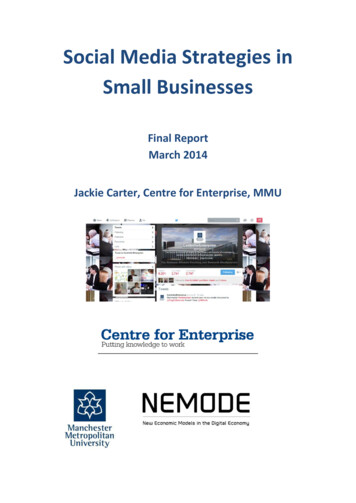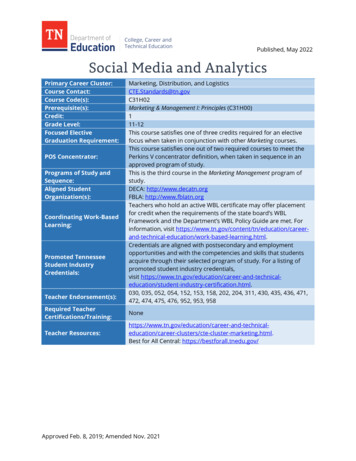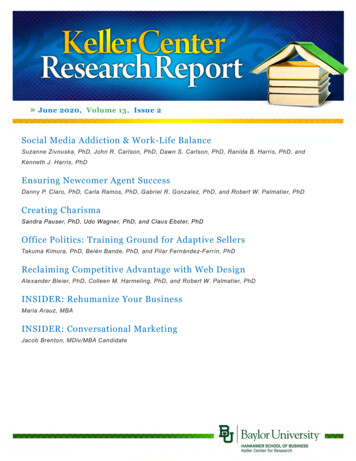
Transcription
»June 2020, Volume 13, Issue 2Social Media Addiction & Work-Life BalanceSuzanne Zivnuska, PhD, John R. Carlson, PhD, Dawn S. Carlson, PhD, Ranida B. Harris, PhD, andKenneth J. Harris, PhDEnsuring Newcomer Agent SuccessDanny P. Claro, PhD, Carla Ramos, PhD, Gabriel R. Gonzalez, PhD, and Robert W. Palmatier, PhDCreating CharismaSandra Pauser, PhD, Udo Wagner, PhD, and Claus Ebster, PhDOffice Politics: Training Ground for Adaptive SellersTakuma Kimura, PhD, Belén Bande, PhD, and Pilar Fernández-Ferrín, PhDReclaiming Competitive Advantage with Web DesignAlexander Bleier, PhD, Colleen M. Harmeling, PhD, and Robert W. Palmatier, PhDINSIDER: Rehumanize Your BusinessMaria Arauz, MBAINSIDER: Conversational MarketingJacob Brenton, MDiv/MBA Candidate
Keller Center Research ReportBaylor University, Keller Center for ResearchHankamer School of BusinessOne Bear Place #98007, Waco, TX 76798www.baylor.edu/kellercenter » Keller Center@baylor.eduKeller Center Research Report is a trademark owned by Baylor University. Baylor University. All rights reserved.Editorial StaffRandy Hacker, MBAExecutive DirectorMarjorie Cooper, PhDEditorAmanda Rodriguez, MBAAssociate EditoriKeller Center Research ReportJune 2020, Volume 13, Issue 2
Table of ContentsSocial Media Addiction & Work-Life Balance1Suzanne Zivnuska, PhD, John R. Carlson, PhD, Dawn S. Carlson, PhD, Ranida B. Harris, PhD,and Kenneth J. Harris, PhDEnsuring Newcomer Agent Success6Danny P. Claro, PhD, Carla Ramos, PhD, Gabriel R. Gonzalez, PhD, and Robert W. Palmatier, PhDCreating Charisma11Sandra Pauser, PhD, Udo Wagner, PhD, and Claus Ebster, PhDOffice Politics: Training Ground for Adaptive Sellers15Takuma Kimura, PhD, Belén Bande, PhD, and Pilar Fernández-Ferrín, PhDReclaiming Competitive Advantage with Web Design20Alexander Bleier, PhD, Colleen M. Harmeling, PhD, and Robert W. Palmatier, PhDINSIDER: Rehumanize Your Business27Maria Arauz, MBAINSIDER: Conversational Marketing31Jacob Brenton, MDiv/MBAiiKeller Center Research ReportJune 2020, Volume 13, Issue 2
Social Media Addiction & Work-Life BalanceSuzanne Zivnuska, PhD, John R. Carlson, PhD, Dawn S. Carlson, PhD,Ranida B. Harris, PhD, and Kenneth J. Harris, PhDInternet addiction is regarded as a growing health concern in many parts of the world, with somestudies estimating rates of addiction between 1.5% and 8.2% in the United States and Europe,and as much as 7% in some Asiancountries. Social media usage inparticular continues to grow inpopularity and contributes to the risingrates of internet addiction.The use of social media is becomingpervasive and rapidly bleeding into thereal estate industry. Some of this use ispositive, as it helps agents build theirprofessional networks and obtain workrelated information and feedback.However, although social media may beseen as a resource that can build social networks and aid in crowdsourcing information, it canalso be a potential resource drain in the same manner as the other new technologies.We hope to clarify our understanding of how social media can drain resources in the workplaceby examining the impact of social media addiction and how employees react to social mediaposts by their colleagues and ultimately the impact of these social media interactions on jobperformance.About our StudyAddictive behaviors are thought to be grounded in the social and environmental context of thedependent person and are associated with emotional distress. For example, studies show that ageneralized addiction to the Internet, or even addiction to smartphones, may be accompanied byloss of interests, decreased psychosocial functions, social retreat, and psychosocial distress.Although not specific to social media addiction, Internet addiction and other addictive behaviors,such as pathological gambling, have been associated with depression and stress, deterioratingquality of life, and loneliness.We investigate the intersection of social media and the workplace, focusing on job performanceimpacts of agents’ social media addictions and social media reactions through work-familybalance and burnout. The research model is grounded in conservation of resources theory (COR),which suggests social media compulsions and emotional reactions to co-worker’s social mediaposts will deplete agents’ energetic and productive resources, making it difficult to achieve1Keller Center Research ReportJune 2020, Volume 13, Issue 2
Social Media Addiction & Work-Life Balancework-family balance, increasing the likelihood of job burnout, and ultimately degrading jobperformance.Impact of Social Media AddictionSocial media can be defined as a technology platform facilitating “social interaction amongpeople in which they create, share, or exchange information and ideas in virtual communities andnetworks.” Because social media is so interactive, it tends to be very reinforcing; people use it tostimulate online conversations and get feedback about their activities, interests, and opinions. Forthis reason, it can lead to habitual, or addictive, posting and monitoring behaviors. Therefore, wedefine social media addiction as “the excessive use and habitual monitoring of social mediamanifested in compulsive usage that comes at the expense of other activities.” We found that65% of adults check Facebook every day, 1 in every 7 minutes is spent on Facebook, andsmartphone users check Facebook 14 times a day on average. When normal use crosses the lineinto addictive behavior, the resource use itself creates more stress due to its demand on time,effects withdrawal, lack of control, and negative consequences associated with its use.Our results show that there is a pathof addictive behaviors that hinder theability to achieve work-familybalance. Lack of work-familybalance ultimately leads to decliningjob performance. As an individualbecomes more addicted to socialmedia, the time and energy that would have otherwise been devoted to accomplishingexpectations at work and at home are depleted in favor of spending that time and energy onsocial media. As a result, a real estate agent is less likely to be able to accomplish goals at workor in his or her family life, creating a distinct lack of balance in both domains.Impact of Social Media ReactionsSocial media users may experience emotional reactions when reading other people’s postsbecause people post on social media for the primary purpose of getting reactions from others inthe form of likes, comments, and shares. Therefore, we define these social media reactions as the“emotions that people experience in response to reading other people’s social media posts.”The results of our study reveal that these emotional reactions, particularly in response to postsfrom colleagues, have the potential to influence work-related outcomes such as job burnout andultimately job performance. This path is all about the emotional response to social mediainformation and how that emotional response creates a cascading effect related to the depletionof emotional resources. For example, a strong anger reaction can increase blood pressure, heartrate, adrenaline, cortisol, and muscle tension, among other responses. Emotions may even have a2Keller Center Research ReportJune 2020, Volume 13, Issue 2
Social Media Addiction & Work-Life Balancepervasive effect on mood. Respondents with strong reactions were more likely to report jobburnout leading to decreased performance.We also note a correlation between job burnout and work-family intersection. They operate bothas predictors and consequences. As job burnout increases, work-family balance decreases, withthe reverse also being true.Practical ImplicationsOur findings stand to make important practical contributions to real estate agency managers andemployees alike. Agents may use social media to distract themselves from stressful or boringwork situations or to procrastinate on work projects. Studies on compulsive Internet use suggestthat some users become overly attached to using web-based applications, which can result inimpairment at several levels, including psychological, social, and professional.The path of addictive social media use to lack of work-life balance and ultimately degraded jobperformance suggests that the harmful effects of social media use can be managed by simpletime management strategies. For example, rather than checking social media on an ongoing basisthroughout the day, constraining social media time or putting time constraints on it may help realestate managers and employees better devote their time and energy to work-related activities thatenhance their job performance. Agencies could support these efforts by reserving some time atthe beginning or end of each day for social media or installing timers that start when socialmedia apps are opened and notify users when an amount of time has passed. Encourage agents tofind productive outlets, such as going on an afternoon walk, to reduce stress and boredom.Understanding the relationship between social media use and job performance is just the firststep for both managers and employees to combat the deleterious effects discussed above;practical changes must be implemented.Recommended ReadingZivnuska, Suzanne, John R. Carlson, Dawn S. Carlson, Ranida B. Harris, and Kenneth J. Harris(2019), “Social Media Addiction and Social Media Reactions: The Implications for JobPerformance,” The Journal of Social Psychology, 159(6), 746-760.About the AuthorsSuzanne Zivnuska, PhDChair and Professor – Management Department, California State UniversityDr. Suzanne Zivnuska (PhD – California State University), Director of the ProfessionalConsulting Program at Chico State, combines more than a decade of academic and consultingexperience in management with real world experience in the health care industry. Suzanne haspublished more than 20 articles in top journals in her field in outlets such as Human Relations,3Keller Center Research ReportJune 2020, Volume 13, Issue 2
Social Media Addiction & Work-Life BalanceJournal of Occupational Health Psychology, and Career Development International. Shemaintains an active consulting practice in human resource management and is committed toproviding her students with practical, active learning experiences in the classroom.John R. Carlson, PhDAssociate Professor - Information Systems, Baylor UniversityDr. John Carlson (PhD – Florida State University) teaches desktop and mobile app developmentand has a longstanding interest in the impacts of software design on users and organizations. Hisresearch interests include the effects of computer-mediation on communication, decisionmaking, and workplace deception as well as the effects of social networking in the organization.John’s recent work has appeared in Management Information Systems Quarterly, the Academy ofManagement Journal, and Computers in Human Behavior.Dawn S. Carlson, PhDH. R. Gibson Chair of Organizational Development – Management and Professor ofManagement and Entrepreneurship, Baylor UniversityDr. Dawn Carlson (PhD – Florida State University) studies workplace issues, such as abusivebosses and working mothers. Her work has been published in numerous journals such asthe Journal of Applied Psychology, Journal of Management, and the Journal of Business Ethics.She is co-author of a book “Beyond Juggling: Rebalancing Your Busy Life.” In 2009, Carlsonwon both the Outstanding Professor in Scholarship and Distinguished Professor awards fromBaylor University. In 2018, she received the Distinguished Doctoral Alumna award from FloridaState University, and in 2019, she was named one of the top extraordinary contributors to workand family research by Community, Work, & Family.Ranida B. Harris, PhDProfessor of Management Information Systems, Indiana University SoutheastDr. Ranida B. Harris’ (PhD – Florida State University) research interests include the effects ofcomputer technologies on communication, performance, and decision making. Her publicationsappear in journals such as Journal of Organizational and End User Computing, Journal ofInformation Systems Education, and Information Systems Education Journal. Dr. Harris’teaching interests include business computer applications, business data analytics, EnterpriseResource Planning (ERP) Systems, systems analysis and design, and database managementsystemsKenneth J. Harris, PhDAssociate Professor of Management, Indiana University SoutheastDr. Kenneth Harris (PhD – Florida State University) has developed a national and internationalreputation for his groundbreaking research in the areas of leadership and abusive supervisorybehaviors, and he is shaping the course and development of research in these areas. His workfocuses on the effect that abusive supervisory relationships have on job performance, coworkers4Keller Center Research ReportJune 2020, Volume 13, Issue 2
Social Media Addiction & Work-Life Balanceand the workplace as a whole. His research is published in major journals of his field such asLeadership Quarterly and The Journal of Social Psychology, and his work has been cited notonly in scholarly publications but also in popular media, such as Forbes.5Keller Center Research ReportJune 2020, Volume 13, Issue 2
Ensuring Newcomer Agent SuccessDanny P. Claro, PhD, Carla Ramos, PhD, Gabriel R. Gonzalez, PhD, andRobert W. Palmatier, PhDEven as U.S. companies spend more than 900 billion on building sales forces, salespersonturnover has reached 27%, and average tenures are as short as two years. According to the SalesManagement Association, most firm-designed salesperson development efforts fall short,because newcomer socialization into a sales role largely results from self-directed activities thattake place informally. Mitigating these trends within the real estate industry requires ensuring theearly success of new agents. Through relationships with peers, real estate agents can obtain theinformation and support needed to master their job tasks, obtain role clarity, and fit in socially.This article explores the impact of key agent-to-agent relationship characteristics on the successof real estate agents as they gain tenure in their firm. It first reveals the impact of relational tiechanges over time, by providing evidence of two different effects of teaming (cooperative) andspanning (individualized) relational structures on salesperson sales growth over their tenure. Thearticle also considers other factors including territory potential, headquarter distance, and agenteducation.Relational TiesA relational tie refers to the link between two salespeople, which influences their actions. A keyaspect of real estate agent ties is the directionality of the exchanges—reciprocal and unilateralties.Reciprocal ties occur when a real estateagent shares resources with a peer, whoshares resources in return, commonlyreferred to as two-way interactions.These exchanges are established aspeople collaborate symmetrically andmutually share their deeper similarities,such as attitudes, knowledge, orexperience. For example, one surveyrespondent stated, “In the (sales)training, I got very close to anotheragent. Whenever I need something, weshare ideas. She also asks, but I ask more than she does, because she has been at the firm for along time.”Unilateral ties result when real estate agents’ views of their similarities are one-sided or whenone party shares knowledge or experiences but the other does not. As one salesperson stated, “If6Keller Center Research ReportJune 2020, Volume 13, Issue 2
Ensuring Newcomer Agent SuccessI’m going to meet a new customer and I have an idea about my colleagues’ profile or knowwho’s the expert in that type of customer, I go to them with these cases and ask what’s the mostsuitable approach.” In this case, one agent is viewed as an expert and the information exchange isone-sided.Relational StructureRelational ties are embedded in larger relational structures—which we distinguish as teaming orspanning—and impart very different benefits to agents.In a teaming structure, agents are part of a structure of highly interconnected salespeople whowork as a cooperative entity. A teaming structure provides peer cooperation by configuring agentrelational ties that are characterized by interdependence and strong norms, which motivate peersto exchange resources. This structure improves performance by encouraging collaboration andcooperation. For example, real estate agents in workgroups that embrace strong cross-sellinggroup norms exhibit greater motivation to engage in cross-selling themselves, which makes themmore likely to promote the firm’s complete portfolio. Agents who maintain intrafirmrelationships made of cooperative ties are much better able to coordinate intrafirm expertise andserve customers.In a spanning structure, agents serve as a link between otherwise unconnected others and gainaccess to information and interpersonal influence. A spanning relational structure provides realestate agents with access to and control over additional resources. These agents take anintermediary position and leverage novel information, which motivates peers to exchangeresources with them. Spanning research suggests the resulting benefits include access to andcontrol over dispersed expertise and a capacity to influence peer salespeople. Agents who spanpeer networks through highly central managers can leverage diverse, competitive intelligencegained from those networks. Real estate agents who maintain a more diverse set of ties generatemore innovative solutions for customers.Other FactorsTerritory PotentialTerritory refers to the environment in which real estate agents must generate sales and realizeperformance objectives. Sales potential in the territory affects customer coverage, performanceevaluations, rewards, and travel time. When potential sales in a territory increase, so do sales andgrowth opportunities, which makes it easier to close sales, facilitating socializing into the salesrole. The agent can act more independently and rely less on social interactions with peers,needing their help less in terms of collaborative efforts or inputs for innovative solutions. Interritories with high sales potential, there are enough opportunities for agents to find new salesand grow, decreasing the chance of conflict or the need to influence others. These benefits do notapply to territories with modest sales potential, where agents struggle to make sales.7Keller Center Research ReportJune 2020, Volume 13, Issue 2
Ensuring Newcomer Agent SuccessPhysical Proximity to HeadquartersWhen located farther away from headquarters, agents are less dependent on non-redundantinformation or interpersonal influence to realize their sales goals. Real estate agents who occupymore peripheral positions in their firm tend to invest more in relationships with fellow peers whoalso are peripheral. Greater headquarter distance also can diminish identification with the firm orencourage out-group stereotyping.Education LevelSalespeople with more education have a greater capacity for critical thinking, effective problemsolving, and learning. They can learn roles in the firm, organizational norms, and culture morequickly, rapidly acquiring role-specific knowledge, skills, and competencies. They also tend tobe more knowledgeable about organizational practices in general and can successfully negotiatesales. As a result, the benefits of teaming likely diminish for well-educated real estate agentswho can act independently, not relying on peer cooperation to carry out their work.Managerial ImplicationsHelping newcomers gain entry into a network of interconnected contacts is critical. In addition toone-to-one peer mentorship programs, firms might encourage multi-peer mentorship models tofoster a teaming structure. Managersalso need to help newcomers avoidisolation or sparse initial connectionswith peers, which would hinder theireffective socialization and performance.A steep learning curve and associatedworkloads might increase the risk ofisolation, so firms should considerexplicitly scheduling activities in theoffice that involve other agents to grantnewcomers more opportunities tointeract with these peers.Managers may also use our findings to identify effective newcomer relationship activities overtime, initially focusing on building reciprocal exchanges to gain work task knowledge and roleclarity quickly. Ways to encourage connections may include revealing newcomer backgrounds topeers, involving salespeople in more team-building exercises such as retreats off-site locations,designing sales training sessions that require more interaction, and pairing newcomers with highability peers to encourage direct observation and teaching.To encourage longer tenured agents to join more spanning relational structures, managers shouldcreate opportunities for salespeople to connect with others outside their immediate social circles,such as arranging cross-territory collaborations to explore potential synergies. Agencies also can8Keller Center Research ReportJune 2020, Volume 13, Issue 2
Ensuring Newcomer Agent Successproactively help tenured agents enter more unilateral exchanges, such that they solely send orreceive information, to move them into more spanning structures.Agents in territories with greater sales potential or who are farther away from HQ do not needthe spanning benefits as much to reach their sales objectives. Agency decisions about salesterritory allocations and designs can thus determine the effectiveness of spanning structures for asalesperson. Similarly, salespeople with more education and who already hold some crucial skillsdo not require teaming structures to the same extent to adapt to their role or join a workgroup.Those with less education should be strongly encouraged to leverage teaming structures to adjustto their role and gain task mastery.These peer-to-peer interactions are essential in ensuring the success of new real estate agents inmastering their job tasks, obtaining role clarity, and fitting in socially.Recommended ReadingClaro, Danny P., Carla Ramos, Gabriel R. Gonzalez, and Robert W. Palmatier (2019), “DynamicEffects of Newcomer Salespersons’ Peer Relational Exchanges and Structures on Performance,”International Journal of Research in Marketing, ut the AuthorsDanny P. Claro, PhDProfessor of Marketing, School of Business, Insper Education and Research InstituteDr. Danny Claro (PhD – Wageningen University and Research Center) conducts research in thefields of sales management, sales networks, and relationship marketing in a B2B environment.He is a Scholarship Researcher participating in a Study on Productivity of the National Councilfor Scientific and Technological Development. His papers have been published in journals suchas Journal of Marketing, Journal of the Academy of Marketing Science, International Journal ofResearch in Marketing, Journal of Retailing, Journal of Personal Selling and SalesManagement, Psychology & Marketing, Journal of Management Studies, Industrial MarketingManagement, and Journal of Supply Chain Management among others.Carla Ramos, PhDAssistant Professor, School of Business, Insper Education and Research InstituteDr. Carla Ramos’s (PhD – University of Bath) research interests include business-to-business(B2B) marketing, sales force, industrial networks, services marketing, cognition andentrepreneurship. She has worked and taught marketing at a number of institutions such as theSchool of Economics of the University of Porto in Portugal, the Bordeaux Ecole de Management(BEM) in France, the University of St. Gallen in Switzerland, and the Manchester BusinessSchool (MBS), University of Manchester in England. She has published her work in theInternational Journal of Research in Marketing, Industrial Marketing Management, Journal of9Keller Center Research ReportJune 2020, Volume 13, Issue 2
Ensuring Newcomer Agent SuccessPersonal Selling and Sales Management, the Journal of Business and Industrial Marketing,among others.Gabriel R. Gonzalez, PhDAssistant Professor of Marketing, San Diego State UniversityDr. Gabriel Gonzalez’s (PhD – Arizona State University) areas of research and expertise includethe management of customer relationships, sales force management strategies, effective serviceinfusion approaches for product manufacturing firms, and the effects of interpersonal networksamong buying and selling firms on financial and relationship performance. Dr. Gonzalez haspublished extensively, and his research has appeared in leading journals such as the Journal ofMarketing, Journal of the Academy of Marketing Science, Industrial Marketing Management,Journal of Personal Selling and Sales Management, the Journal of Services Marketing, amongothers. His research has received numerous awards, such as the James M. Comer Award for thearticle making the best contribution to selling and sales management theory in the Journal ofPersonal Selling and Sales Management.Robert W. Palmatier, PhDProfessor of Marketing and John C. Narver Chair in Business Administration, Universityof WashingtonPrior to entering academia, Dr. Robert Palmatier (PhD – University of Missouri) held variousindustry positions, including President & Chief Operating Officer of C&K Components andEuropean General Manager at Tyco-Raychem Corporation. He also served as a U.S. NavyLieutenant onboard nuclear submarines. His research has appeared in Journal ofMarketing, Journal of Marketing Research, Marketing Science, Journal of Retailing, Journal ofConsumer Psychology, Journal of Academy of Marketing Science, and International Journal ofResearch in Marketing. He is the editor-in-chief for the Journal of the Academy of MarketingScience and Area Editor for Journal of Marketing. He has received the Harold H. Maynard, LouW. Stern (3 times), MSI Young Scholar, Varadarajan Award for Early Contribution to MarketingStrategy Research, and the American Marketing Association Best Services Article awards. Hehas received numerous teaching awards for EMBA and MBA teaching including MBA Professorof Year, Robert M. Bowen EMBA Excellence in Teaching Awards (3 times), and PhD StudentMentoring Award (2 times).10Keller Center Research ReportJune 2020, Volume 13, Issue 2
Creating CharismaSandra Pauser, PhD, Udo Wagner, PhD, and Claus Ebster, PhDSelling success often depends on an agent’s ability to create favorable impressions; thus, theability to manage client perceptions is of great importance. The literature almost unanimouslystresses the importance of charisma as a prominent determinate for success within variousdisciplines, including sales.Charisma stems from the Greek wordcharismata, which means “gift ofgrace,” implying that charisma is inborncharacteristic. In modern thought,however, charisma is consideredlearnable. Charismatic individuals canconvey messages in a convincingmanner to charm their followers.Applying this concept to a personalselling context, we define charisma asthe articulation of communicationmessages that enhance a salesperson’s appeal.Our research identifies specific, learnable, and culturally appropriate displays of charismaticbehavior as a means of enhancing client impressions and ultimately increasing sales.About our StudyPrevious research in other social science disciplines has identified enhanced body movements asa driver of charisma. The results of our study extend previous findings, identifying specificnonverbal cues to use during the selling process. We measured and examined specific nonverbalbehaviors which increase perceived charisma, an important driver of salesperson effectiveness,and thus buyers’ attitude toward the salesperson.In the first of our two studies, salespeople from two different cultures pitched their respectiveproducts or services in a one-minute standardized setting. The individuals’ nonverbal behaviors,including body action and posture, were objectively coded using a time-locked coding scheme.In the second study, participants evaluated the videotaped sales presentations assessing thesalesperson’s charisma and indicating their attitudes toward them. We then analyzed the codedbody actions and postures and participant’s evaluation of the salesperson’s charisma, as well asattitudes towards them.11Keller Center Research ReportJune 2020, Volume 13, Issue 2
Creating CharismaOur FindingsConsistent with previous findings in personal selling and service marketing, we show thatnonverbal communication matters in a personal selling context. Nonverbal messages enhance asalesperson’s charismatic appeal, which in turn, leads to favorable attitudes towards thesalesperson. Beyond that, our findings suggest that symmetrical and non-symmetrical armactions and postures, depending on culture, have significant effects on charismatic appearance.We expand prior literature by providing evidence that charisma is culture-specific in the sensethat symmetrical or asymmetrical gesturing yields contrary outcomes. While charisma is auniversal phenomenon, the results of this cultural comparison indicate that nonverbal behaviorsthat predict charisma in a sales conversation are of particular importance to international salesrepresentatives. Within low-gesturecultures, such as the United States orCentral Europe, an emphasis shouldbe placed on symmetrical armpostures, actions and functions (seeFigure 11 and Figure 21). In contrast,asymmetrical movements should beemphasized in high-gesture cultures,such as Israel (see Figure 31).Figure 1.Figure 2.Figure 3.Please note, sales professionals located in high-gesture countries should exercise caution whenapplying the findings of previous studies on nonverbal charismatic behaviors, as many priorstudies have neglected to consider cultural context.Managerial ImplicationsOur findings show that specific, learnable displays of charismatic behaviors can be used as ameans of enhancing client impressions. Considering that nonverbal c
Dr. Dawn Carlson (PhD - Florida State University) studies workplace issues, such as abusive bosses and working mothers. Her work has been published in numerous journals such as the Journal of Applied Psychology, Journal of Management, and the Journal of Business Ethics. She is co-author of a book "Beyond Juggling: Rebalancing Your Busy Life."
